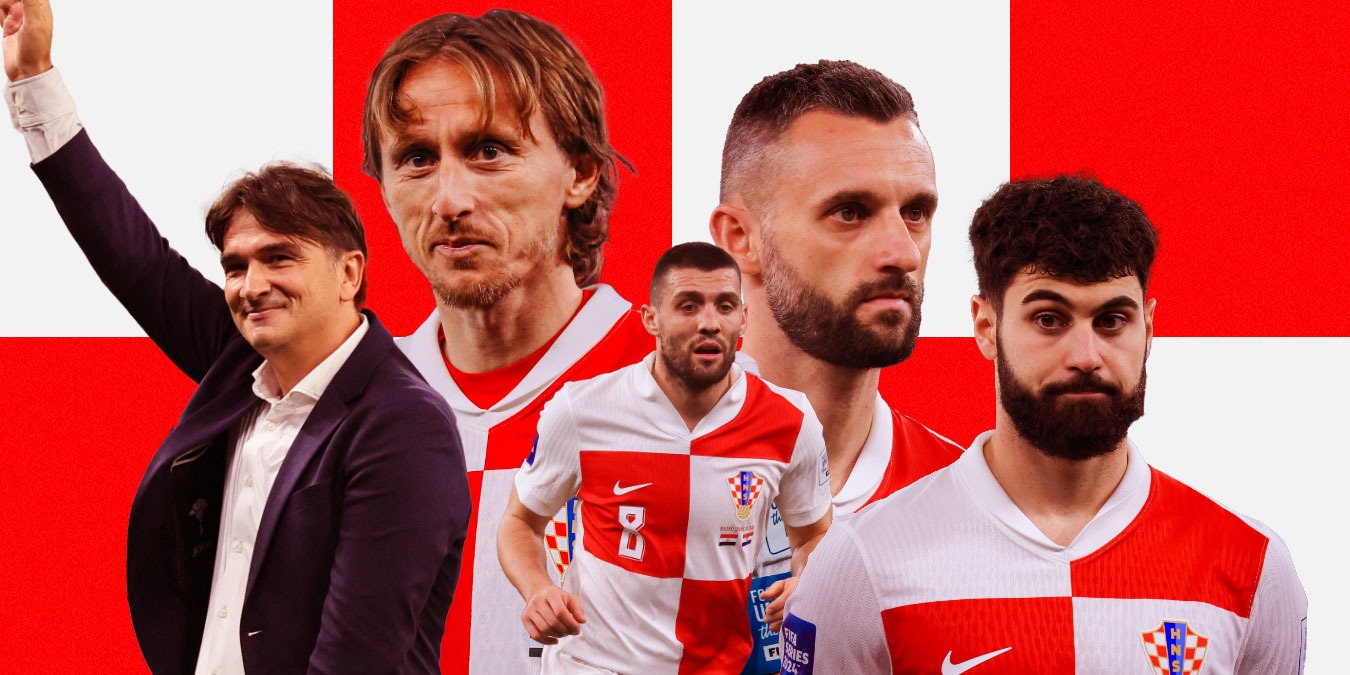Croatia will go into yet another major tournament with their trademark experienced midfield trio of Marcelo Brozovic, Luka Modric and Mateo Kovacic. But has Zlatko Dalic done enough to oversee a generational transition ahead of Euro 2024?
With Euro 2024 approaching, the predominant narrative around Croatia has centred on the end of an era, with a 38-year-old Luka Modric riding off into the sunset and a team ultimately needing to replace two of the best midfielders of their generation… or three if we’re counting Marcelo Brozovic alongside Modric and Ivan Rakitic.
“I think this is the ideal time for the younger players in our setup, who are playing well at their clubs, to be given a chance to play for the Reprezentacija, for they’ll soon have to carry this team,” Croatian coach Zlatko Dalić said.
“In the near future, Croatia will be without Modric, Rakitic, [Ivan] Perisic, [Dejan] Lovren and [Domagoj] Vida, and the time will come where other players have to take on their roles.”
While that quote from Dalic may seem recent on the surface, it was actually from September 2020, before Croatia were trounced 4-1 away to Portugal in the Nations League.
In the four years since, the only relatively young player to lock down a starting spot for the Vatreni is Manchester City’s Josko Gvardiol. Despite a bronze medal at the recent World Cup in Qatar, integrating a new generation has largely been put on the backburner.
That has not been because of a lack individual player quality, however, but rather the utilisation and balance of distinct player profiles and attributes.
The Context: Croatia’s Need for the Ball
On the pitch, Croatia are… different.
Since Rakitic and Modric announced themselves at Euro 2008, their cerebral and improvisational approach in midfield has served as a contrast to the predominant tasks of duel-winning and ball circulation in international football.
Meanwhile, Brozovic emerged as the ultimate foil to the pair, essentially becoming Sergio Busquets with neck tattoos and a motor at the base of midfield at club and international level.
Due to the players that Croatian football produces, the national team needs to play in a way that enables them in order to compete. With a dearth of out-and-out wingers, along with producing midfielders and strikers that are creative but lack physicality, keeping the ball has become Croatia’s best-possible defence mechanism.
To this day, the abundance of creative midfielders Croatian football produces does not fit within the standard, compartmentalised roles of modern European football.
Falling somewhere between the number 8 and number 10 roles, the likes of Lovro Majer and Nikola Vlasic – or more recent examples in Lovro Zvonarek, Martin Baturina or Luka Stojkovic – are at their best advancing between the lines to create, as opposed to retreating from higher positions. This is an especially pertinent point for Vlasic and Majer at club level, as some incompatible spells at West Ham and Wolfsburg can attest to.
What flies under the surface even in local spheres though, especially in the face of Mateo Kovacic replacing Rakitic in that midfield, is that you still need to create with the ball.
Consequently, of the 12 teams that averaged over 400 successful passes per game in Qatar, Croatia (-0.6) had the lowest net expected goals per game, while only Denmark (0.085) had a lower non-penalty xG per shot than the Vatreni (0.089).
That inability to create while playing keep-ball was the dissonance that ultimately accompanied Croatia’s run to the semi-final in Qatar.
Croatia’s dynamics in possession since Euro 2020 have been largely consistent, representing the pros and cons of having Kovacic with Modric and Brozovic in midfield at respective stages of their careers – the team can play its way out of pressure with relative ease and maintain possession, but there’s little substance in the opposition half when they get there.
For a team whose defining attribute used to be its ability to penetrate through the middle of the pitch and force defensive collapses, this is not insignificant.
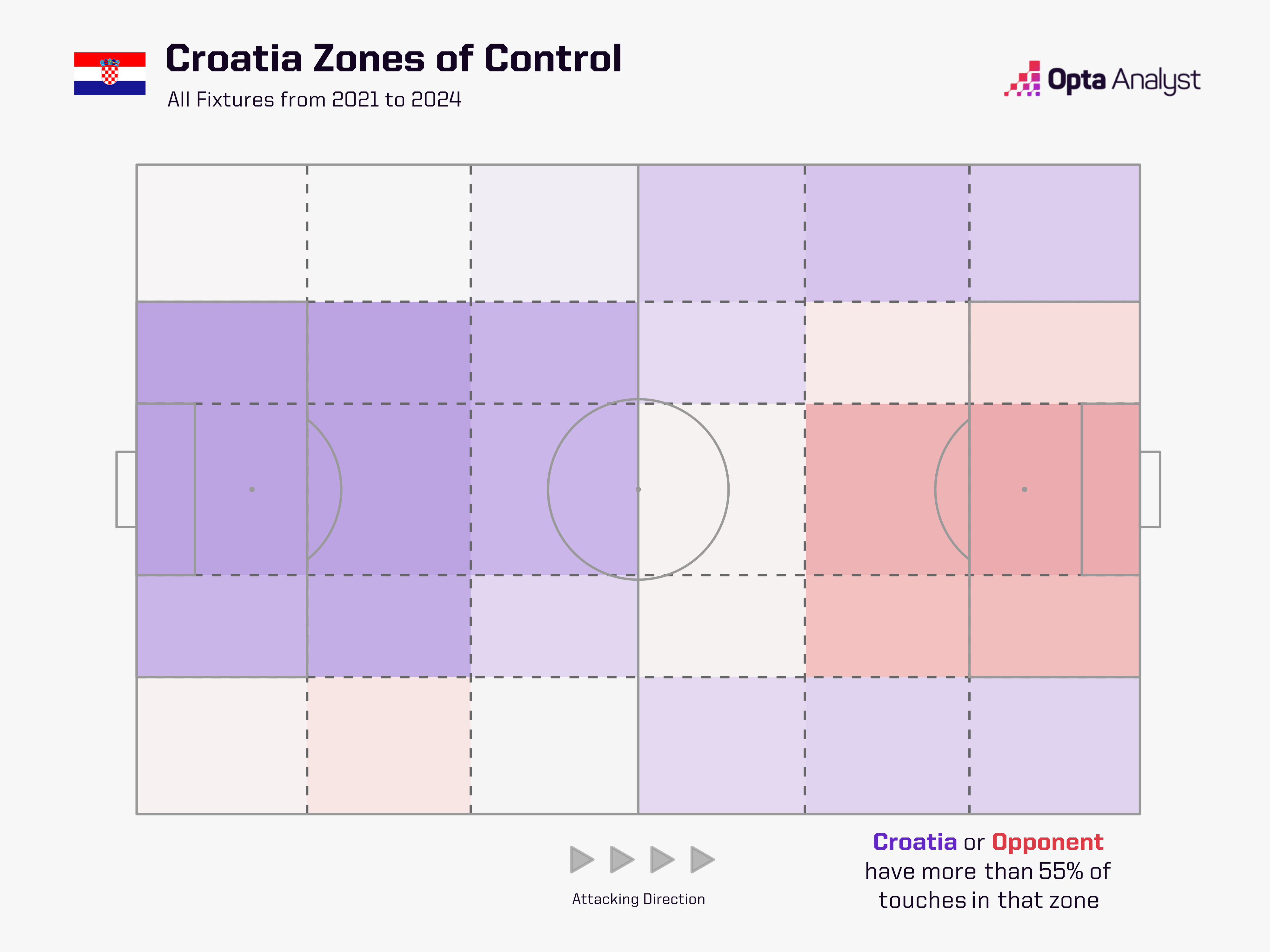
The Path to Germany
The hierarchy in midfield remains and when the stakes were highest in qualification, the trio of Modric, Brozovic and Kovacic started – picking up four points out of a possible 12 from the two games against Turkey and Wales.
Dalic’s side ultimately finished second in Group D on 16 points (a point behind group winners Turkey) and avoided the play-offs after Wales played out two draws in the final qualifying window.
The questions were largely the same as before Qatar, given Dalic’s insistence on the familiar. How do Croatia get the most out of Andrej Kramaric or Bruno Petkovic as the lone forward, given their inclination to come to the ball? Where does Mario Pasalic, Croatia’s most consistent penalty-area threat from midfield, ultimately fit best? And lastly, is Gvardiol playing at left-back or centre-back?
Pasalic played only 310 minutes over eight matches for Croatia in Euro 2024 qualifying, but of those who played 135+ minutes, the team had the highest xG per shot (0.172) from passages in open play where the Atalanta midfielder was involved.
For Dalic, Pasalic’s ground coverage and nose for goal has been most utilised on the wing, but when he’s played out there the obvious trade-off is Pasalic’s lack of one-vs-one ability and weakness as an outlet between the lines, particularly as wingers and full-backs on either side are asked to alternate as the half-space option within Dalic’s set up.
That was evidenced in the last international window against Tunisia. This forces Pasalic to play in areas he’s uncomfortable operating in.
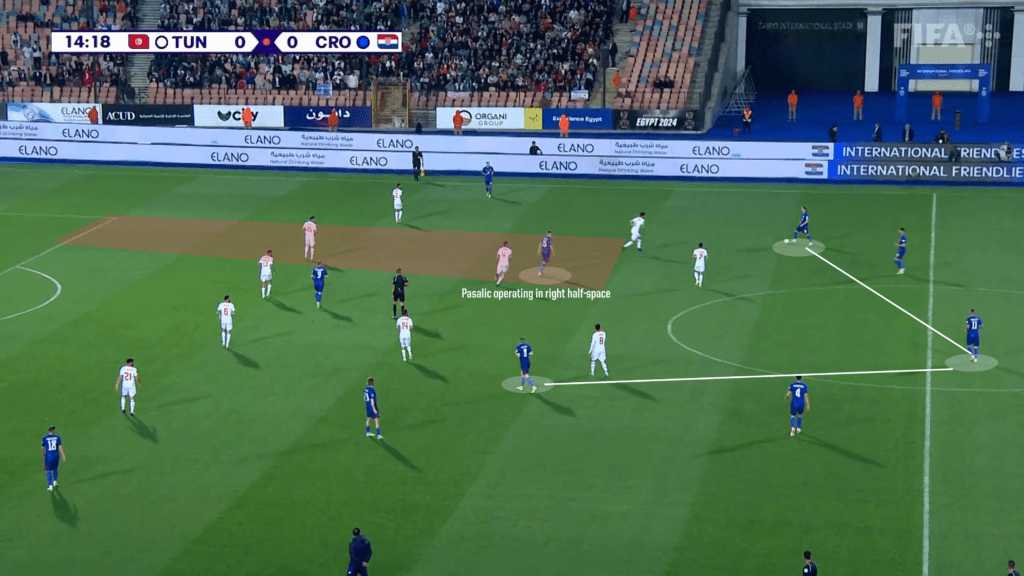
A combination of Pasalic, Majer, Vlasic, Luka Ivanusec and even Kramaric have essentially had to make do out of position in wide areas, with the established trio playing in midfield when it matters most, be it qualification or last year’s final four in the UEFA Nations League. This past season, the bottleneck would have been even further pronounced late in qualifying had Perisic not gone down with an ACL injury last September.
When on the pitch, Majer is prominent in most of what Croatia do well going forward. His combination of final ball and deftness in tight areas means that in all fixtures over the past three years, Majer (6.0) leads Croatia for open-play sequences that end in a shot per 90.
In Euro 2024 qualifying alone, Majer (16.2%) had the highest percentage of open-play involvements that ended in a shot among Croatia’s midfielders. At 26, he’s ultimately playing catch-up in establishing himself as a central figure for the Vatreni, but did start both of Croatia’s most recent friendlies, scoring a brace against North Macedonia.
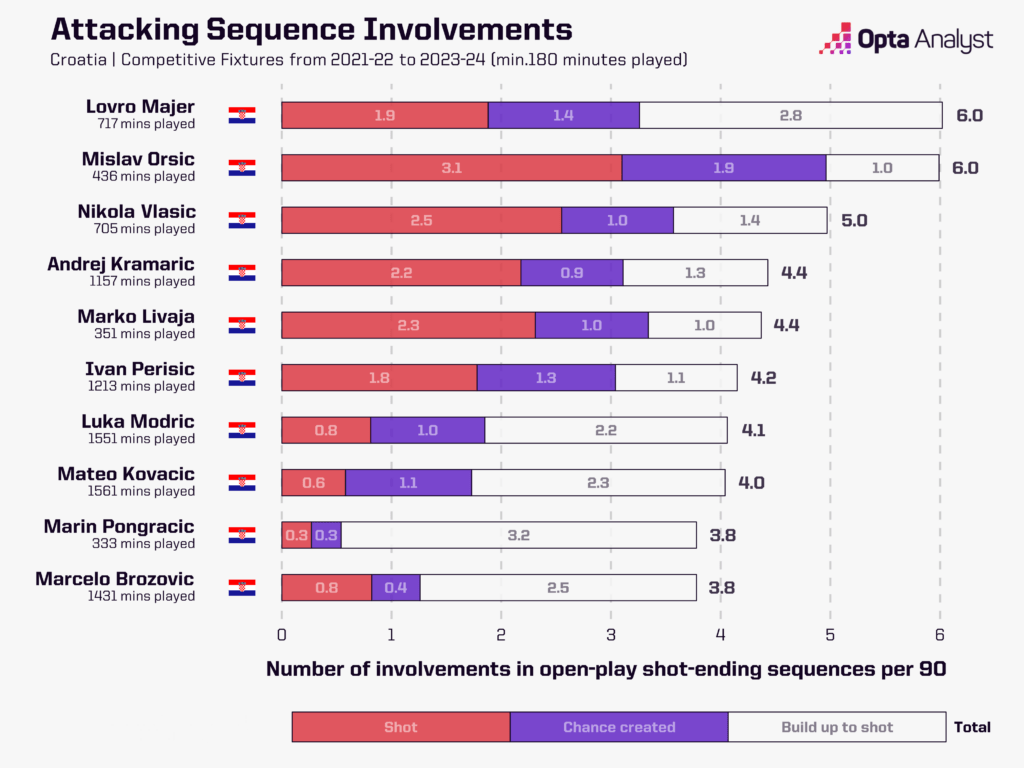
The Potential X-Factors
Arguably as a result of Croatia’s similarity in profile and traditional lack of out-and-out wingers, barring disaster in camp, the other Pasalic – Marco – appears a realistic part of Dalic’s plans in Germany.
His loan move to Rijeka from Borussia Dortmund last season has been ideal for a couple of reasons. The first, obviously, is timing – following an injury-interrupted two seasons with Borussia Dortmund II, the 23-year-old Pasalic desperately needed senior match minutes. A move to Rijeka not only gave him the opportunity to gain those minutes, but within the ideal shop window of Croatia’s domestic league.
The other reason has been his fit at Rijeka under Zeljko Sopic. With Toni Fruk and Niko Jankovic predominantly providing final ball and late runs into the box from midfield, the onus and responsibility to actually create fell upon Pasalic and fellow loanee Marko Pjaca (who has also received a call-up) in wide areas. As such, the pair saw a lot of the ball, and Pasalic particularly benefitted from that.
Among the 79 wingers to have played minutes in the HNL this season, both Pasalic (119) and Pjaca (117) were in the top five for open-play involvements leading to a shot. Meanwhile, only Hajduk Split’s Emir Sahiti (53) completed more successful take-ons than Pasalic (49), who also took the most shots per 90 minutes (3.5) of any winger in the HNL this term.
In some respects, though, quantity did not translate into quality for the left-footed winger. Most of his shots were from distance cutting in from the right, which meant among the 18 players with 50+ non-penalty shot attempts in the HNL this season, only Filip Krovinovic (0.046) had a lower non-penalty xG per shot than Pasalic (0.051).
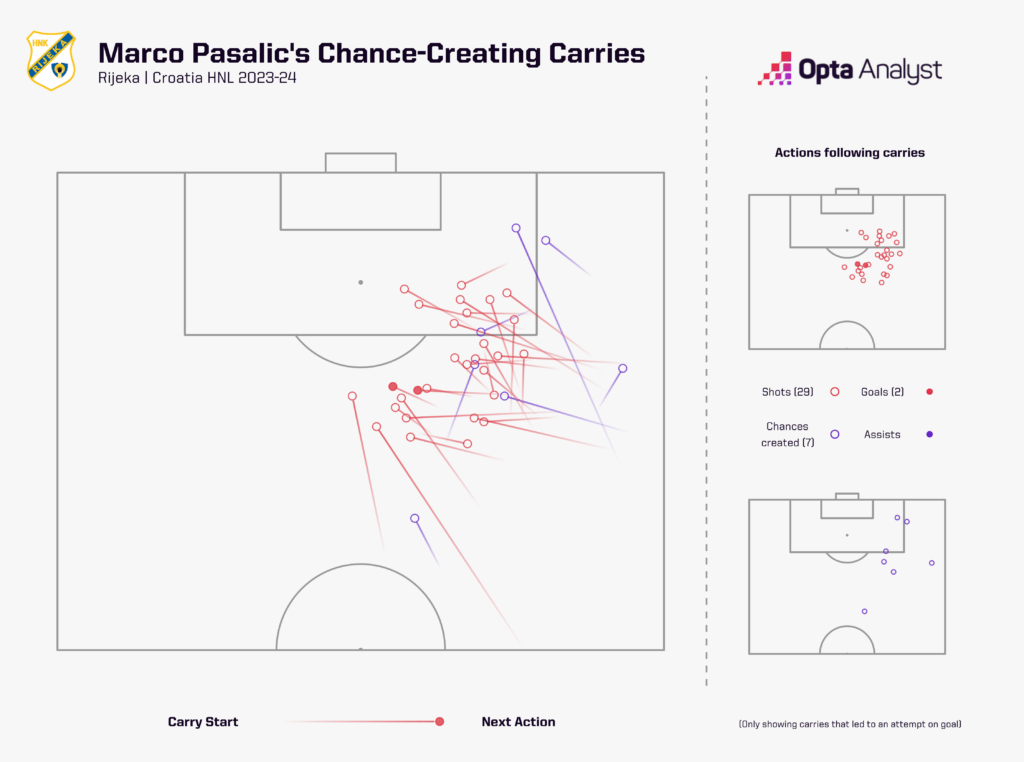
Meanwhile, 20-year-old Martin Baturina appears destined for Europe’s top five leagues and has been the sole creative force for title-winning Dinamo in midfield – especially following Luka Ivanusec’s sale to Feyenoord. However, it will be much harder for him to thrust himself to the forefront of Dalić’s plans in Germany.
Although Croatian football since independence has heavily favoured experience and continuity as opposed to youth, Marco Pasalic represents an overt positional need for the Vatreni. The same cannot be said for Baturina and Red Bull Salzburg’s Luka Sucic, which could see their involvement reduced to impact off the bench.
Enjoy this? Subscribe to our football newsletter to receive exclusive weekly content. You should also follow our social accounts over on X, Instagram, TikTok and Facebook.
